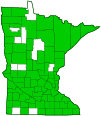common purslane
(Portulaca oleracea)
Conservation • Weed • Wetland • Description • Habitat • Ecology • Use • Distribution • Taxonomy
Description |
Common purslane is a widely distributed, very common succulent weed of disturbed sites. It occurs worldwide on every continent except Antarctica. It is common in Minnesota. It is found in agricultural fields, gardens, and commercial greenhouses, on roadsides, and in other disturbed sites. It is often seen growing in sidewalk cracks. The nativity of common purslane is uncertain. The U.S. Department of Agriculture defines native plants as those that occurred naturally in a particular region withuot human introduction. More commonly, it refers to plants that were present before European colonization began around the late 15th century. It was probably introduced into North America in pre-Columbian times. There is evidence of it in lake deposits in Ontario dating from 1350 to 1539. Nevertheless, most sources continue to classify it as invasive in North America. Its spread is assumed to be resulting from human activity. Today it is widely naturalized across the United States and southern Canada. Common purslane is difficult to control once it becomes established. A single plant can reproduce a vast amount of seeds. The stems and leaves contain much water. When separated form the parent plant, they can regenerate roots and produce a new plant. Common purslane is a 2″ to 6″ tall annual forb that rises on many stems from a stout, ¾″ to 4″ long, taproot. It forms large mats. The stems are X¾″ to 22″ long and lay flat on the ground (prostrate). They are repeatedly branched, round in cross section, thick, fleshy, and juicy (succulent). They are hairless and usually purplish brown, sometimes light green with a reddish tinge. The leaves are alternate, flat, succulent, spatula-shaped to inversely egg-shaped or wedge-shaped, ⅛″ to 1⅛″ long, and 1 ⁄16″ to ½″ wide. They are green and glossy, often becoming reddish-tinged in strong sunlight. They are stalkless or on very short leaf stalks and are often crowded at the end of the branch. They are rounded to nearly straight across at the tip and taper slightly to the base. The upper and lower surfaces are hairless. The margins are untoothed. The inflorescence is a solitary flower or a small cluster of flowers of 2 or 3 at the end of the stem. The flowers are ⅛″ to ¼″ in diameter. There are 2 sepals, 5 petals, 6 to 10 stamens, and 1 style. The sepals are green and usually enclose the flower, opening only on sunny mornings. The petals are yellow, oblong, ⅛″ to 3 ⁄16″long, and 1 ⁄16″ to ⅛″ wide. They are not joined at the base. The stamens have translucent yellow filaments and yellow anthers. The style has 5 branches. The fruit is a round to egg-shaped, ⅛″ to ⅜″ in diameter capsule. It is not winged. It splits around the middle when ripe to release many seeds. |
Height |
2″ to 6″ |
Flower Color |
Yellow |
Similar Species |
Habitat |
Dry to moderate moisture. Gardens, roadsides, agricultural fields, sidewalk cracks, and other disturbed sites. Full sun. |
Ecology |
Flowering |
June to September |
Pests and Diseases |
|
Use |
|
Distribution |
||
|
Sources |
|
| 7/2/2024 | ||
Nativity |
||
The nativity of common purslane is uncertain. |
||
Occurrence |
||
Common and widespread |
||
Taxonomy |
|
Kingdom |
|
Subkingdom |
Pteridobiotina |
Phylum |
Tracheophyta (Vascular Plants) |
Class |
|
Subclass |
Caryophyllidae |
Order |
Caryophyllales (Pinks, Cactuses, and Allies) |
Family |
Portulacaceae (purslane) |
Genus |
Portulaca (purslane) |
Subordinate Taxa |
|
Many subspecies and varieties (subtaxa) of common purslane have been described. Authoritative sources have little agreement on how many variants should be recognized, if any, and what those variants should be. ITIS, USDA PLANTS, and World Flora Online recognize no subtaxa. GRIN, GBIF, and Plants of the World Online recognize two, though not the same ones. iNaturalist lists five subtaxa. NaturServe lists seven. |
|
Synonyms |
|
Portulaca neglecta Portulaca retusa |
|
Common Names |
|
common purslane little hogweed portulaca-weed purslane pursley wild portulaca |
|
Glossary
Prostrate
Laying flat on the ground.
Sepal
An outer floral leaf, usually green but sometimes colored, at the base of a flower.
Succulent
Having thick leaves, stems, or roots that store water. Succulent tissues appear fleshy externally and juicy internally.
Wing
A thin, flat, membranous, usually transparent appendage on the margin of a structure.
Visitor Photos |
||
Share your photo of this plant. |
||
This button not working for you? |
||
Bill Reynolds |
||
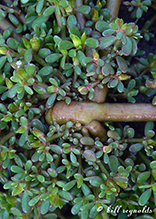 |
|
|
MinnesotaSeasons.com Photos |
||
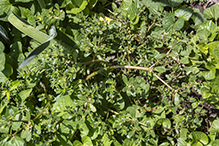 |
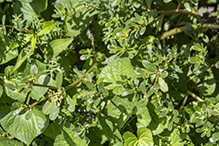 |
|
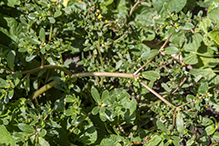 |
 |
|
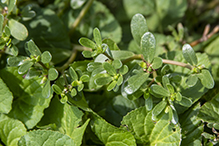 |
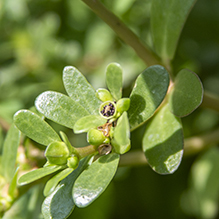 |

Slideshows |
|

Visitor Videos |
||
Share your video of this plant. |
||
This button not working for you? |
||
|
Other Videos |
||
Portulaca oleracea | Purslane (Pt 1 of 2) |
About
Published on Aug 21, 2012 Visit Website: http://www.survivalplantsmemorycourse.com/ Photos used under protection of the "fair use" section (107) of the U.S. copyright act of 1976. http://www.youtube.com/watch?v=S521VcjhvMA&feature=player_embedded |
Portulaca oleracea | Purslane (Pt 2 of 2) |
About
Published on Aug 21, 2012 MNEMONIC EXPLAINED: Vividly imagine seeing a group (many branches; creeping along the ground; mat-like) of oar (oar-shaped leaves) snakes (stems and leaves are thick, succulent and fleshy like snakes [this is a snake plant not a skinny worm plant]). They have torn a lemon (flowers are yellow) apart. Some are eating it (flowers develop where the "stalkless" leaf meets the stem [this "Y" section represents the snake's mouth with the yellow/lemon inside of it]) while others are passing it (after the snakes eat the lemon they poop the lemon and the lemon poop piles up at the tail [this reminds you that yellow flowers can also be found in clusters at the end of branches/snakes]). When they spot you they rise up (plant grows up to 6 inches tall [about average for a rising snake I guess]) and try to bite, so you take your knife and chop the snakes in half. Now watch until the very last drop of blood (stems are reddish) and lemon juice (this plant can be distinguished from it's look-alike by it's clear sap [not milky]) drains out (after the snakes have been drained of it's blood and lemon juice, the skin is no longer reddish but is green now [this reminds you that the stems/snakes can also appear green. |
Common Purslane (Portulaca oeracea) - 2013-08-22 |
About
Published on Sep 3, 2013 Portulaca oleracea (Common Purslane, also known as Verdolaga, Pigweed, Little Hogweed, or Pursley, and Moss rose) is an annual succulent in the family Portulacaceae, which may reach 40 cm in height. --------- 52.01775 4.29993 |
Wild edibles 24: Purslane vs. Spurge |
About
ploaded on Jul 12, 2011 Is it nutritious Purslane or Toxic Spurge? I'll show you how to tell the difference along with some video I took of Sea purslane which is a great survival food since it is found on beaches worldwide. |

Created: 12/1/2013 Last Updated: © MinnesotaSeasons.com. All rights reserved. |
